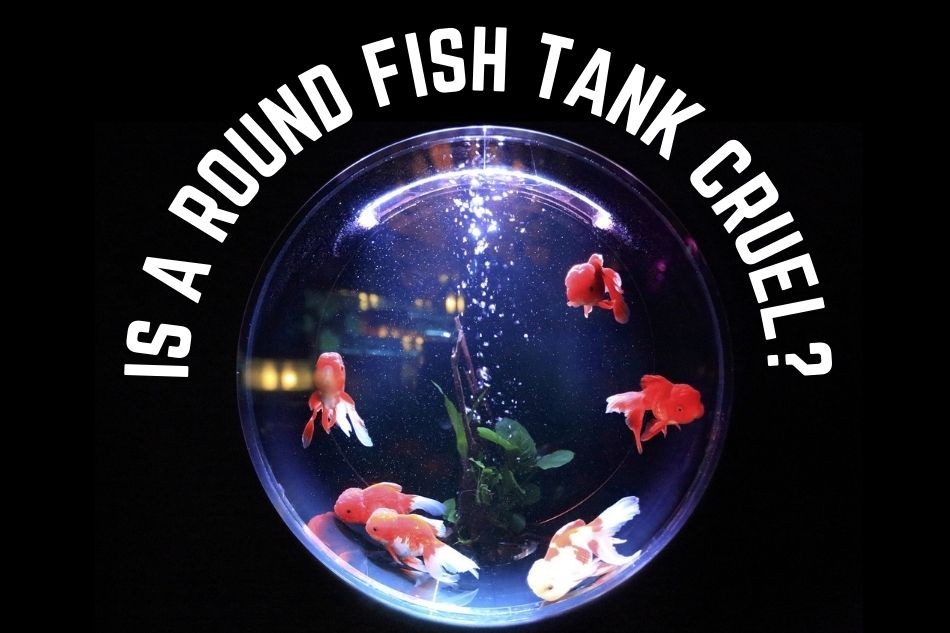This article may contain some affiliate links to products. The links provide me a small percentage of commission but do not cost you anything extra to use. (See full disclosure statement here ).
).
Whether a round fish tank is cruel or not is a bit of a contentious issue. One of the primary things to consider when you are starting out in the fishkeeping hobby is what type and size of tank you will need.
There are a range of tank shapes on the market, from hexagonal to diamond, round to rectangular. And because nobody would deliberately set out to harm the fish they want to keep, I did my own research into the different tank shapes available while I was looking for a new tank.
So are round fish tanks cruel?
A stereotypical small round fish bowl, as seen in cartoons, is considered cruel. But it’s the overall size, not the shape, that really determines whether a fish tank is fit for purpose. Other factors such as filtration, and the general tank setup, are also important for the health of the fish no matter what shape the tank is.
No-one would disagree that keeping one, or even a few fish, in a small space without adequate filtration and oxygenation, wouldn’t be fair on the fish. But this applies equally to a small rectangular tank as much as it does a round one.
Why Do People Think Round Fish Tanks Are Bad?
As I mentioned before, when you talk about a round fish tank most people will jump to the conclusion you mean a small fish bowl. The type you think of with a solitary goldfish swimming around and around all day. And with nothing much else of interest in the bowl.
While there is no doubt that these kinds of habitats are not suitable it doesn’t mean that all round tanks are bad.
A well thought out aquarium setup with a suitably sized tank, no matter what its shape, can look amazing. And smaller less messy fish, can not only survive, but will thrive in it. The video below shows a stunning example of how a fish bowl aquarium setup can be achieved with a little of effort.
What Is Needed To Make a Round Tank Suitable?
As with any shape of aquarium, you must ensure you consider how you will make your fish comfortable enough so they will thrive in the environment you are creating for them. If you don’t want to go down the fully aquascaped tank route, as in the video above, then the list below will help.
- Adequate space for your fish to swim around in – there are tanks available in various sizes. Knowing what type of fish, how big they can grow, and how many you want to keep, will help you to decide what size you will need.
- Filtration – this helps to remove the build-up of debris and waste that your fish and other tankmates create.
- Oxygenation – an air pump helps with the exchange of gases and helps to keep the chemistry levels healthy in your aquarium.
- Substrate – as well as creating a visually more appealing tank, substrate helps to create a larger surface area for the healthy bacteria to grow on. These bacteria are useful in breaking down the fish waste, and food debris, which helps to prevent the water from becoming too toxic for your fish.
- Decorations – although not strictly necessary tank decorations create interest for both you and your fish. Some fish like to hide away every now and then, so having a few decorations in the tank can allow the fish to get a bit of R&R.
- Plants – Live plants can help to oxygenate the tank. They’re also great at helping to filter out excess nutrients from the water column. But if you don’t want live plants then artificial ones are ok too. Again, these create a bit of interest for the tank and create extra surface area for the healthy bacteria to grow on.
- Lighting – You want to be able to enjoy seeing your fish. After all, that’s why you decided to take up the hobby in the first place. So lighting your tank for a set period of time each day will help you to do this.
Once you have your new aquarium set up make sure it is left to stand for 24 hours or longer before adding any fish. This will give your fish a better chance of survival while the tank starts it’s cycling process.
You can cycle the tank and filter in advance by using bottled beneficial bacteria, performing a fishless cycle, or using mature tank water and an already cycled filter from another tank.
But if you’re setting up your first tank, and don’t have any of these things, let the tank run for a day or so. Then keep a close on your fish, and the tank conditions, over the first 4-6 weeks to monitor their progress while the natural cycling process does its thing.
Where To Keep A Fish Bowl
The placement of your fish tank will depend on the space you have available. And also on which part of the house you tend to spend more time in. That way you’ll get the benefit of seeing your fish daily.
But there are a couple of other considerations when it comes to placing an aquarium
- Place your fish tank away from direct sunlight. Although you want to see your fish using an tank light is a better option because direct sunlight can cause excess algae growth in your aquarium.
- Place your fish tank way from any draughty areas, such as doorways, air conditioning or fans. Draughts are not good for your fish. Plus a continual stream of cold air will mean that your aquarium heater will have to work harder to keep the water temperature constant.
Which Fish Can Be Kept In A Bowl?
Even larger sized round tanks or bowls will have restrictions on what fish you will be able to keep. This is no different really to a rectangular tank. If you have a small tank then it’s best to keep away from larger fish. Or ones that will grow too big and will need to be moved after a short time.
Small fish with a low bioload (basically how much they poop) such as Guppies, Neon Tetra, White Cloud Mountain Minnows, Endlers and Rice Fish, are suitable for smaller tanks no matter what the shape is. Shrimp are also a suitable candidate for smaller tanks. Although it would need to be a lidded version because shrimp can be great escape artists given half a chance.
I found that out for myself recently when I was cleaning one of my tanks and an Amano shrimp decided to make a dash for it. It took me over 10 minutes to find him and my heart was in my mouth the whole time. I finally found him hiding under the chair that had the waste water bucket on it. I couldn’t believe he was still alive after so long out of the water. Luckily he seems none the worse for his adventure. But it’s not an experience I want to repeat.
Are Plastic Fish Bowls Safe?
There are different types and grades of plastic some of which are not suitable for making fish tanks out of. This is because some plastic leech chemicals out into the water column. Which is dangerous for the fish and their tankmates.
The plastic most commonly used for fish tanks is acrylic. It’ strong enough to hold the weight of the water and the other contents of the tank. It also gives a clear view of the inside of the tank. And as far as I’m aware, there’s no evidence to suggest that acrylic tanks are unsafe for housing fish. In fact, a lot of tank decorations and fish/shrimp feeding bowls are made of acrylic too.
Acrylic is quite durable, but as with most plastics it can be scratched quite easily. So care is needed when doing your regular tank maintenance. Don’t use any abrasive cleaning equipment or your aquarium or it will look the worse for wear quite quickly. Make sure you buy algae scrapers and so on that are made for use on acrylic tanks.
I know that glass can also be scratched despite its reputation for being more forgiving than acrylic. So again, make sure you only use tools that are suitable for glass tanks.
There are many attractive acrylic round tanks available in various sizes such as these by BioOrb . Available on Amazon.
. Available on Amazon.

